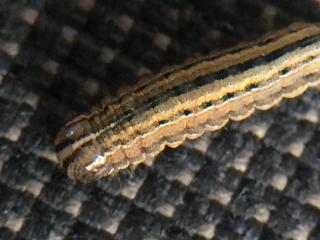Armyworm
- Belka
- York
- Greenhills
- Neridup
David Stead (Anasazi Agronomy) has recently found armyworm caterpillars in wheat at York and Greenhills, and in barley near Belka.
Nicky Tesoriero (Ceres Agronomy) has reported armyworm caterpillars causing chewing damage to wheat, prior to head emergence, near Neridup.
Growers are encouraged to monitor cereal crops for armyworm as they can defoliate plants during vegetative stages and damage heads (especially barley) later in the season during grain fill stages.

Armyworm caterpillars are fat and smooth and may be distinguished by the three parallel white stripes on the collar just behind the head. The first visible sign of armyworm caterpillars is often their green to straw-coloured droppings, about the size of a match head, found on the ground between the cereal rows.
Armyworm caterpillars are most damaging in barley crops close to harvest. When barley crops are maturing in spring, large armyworm caterpillars climb plants and can chew through the stems, causing the heads to fall to the ground. Damage to wheat and oat crops occurs less frequently and is usually minor compared to damage in barley because the stems are thicker and leaf defoliation does not usually result in yield loss. Armyworms are seldom a serious problem in pastures.
Assessing the number of armyworm in a cereal crop can be difficult, as their movements will vary with weather conditions and feeding preference. Sometimes they are found sheltering on the ground and under leaf litter whilst on other days they will be high up on the plants or on the heads, and easily picked up using sweep nets. Larger caterpillars often prefer to hide during the day and feed at night.
Growers should be mindful to distinguish recently introduced fall armyworm caterpillars from native budworm caterpillars given the incidence of budworm in cereal crops this season.
The economic level for spraying armyworm in mature barley is about three large armyworm grubs per square metre of crop. The threshold for wheat or oats is much higher as only grains are consumed and heads are very rarely dropped. Spray thresholds in these crops are more like 10 grubs per square metre of crop. For more armyworm threshold information, refer to DPIRD’s Management of armyworm in cereal crops page.
A number of effective insecticides are registered for the control of armyworm if required (see DPIRD’s 2021 Winter Spring Insecticide Guide). However, their effectiveness is dependent on good penetration into the crop. This can be difficult to achieve in high-yielding, thick canopy crops, especially when caterpillars are resting under leaf litter at the base of plants. Spraying late in the afternoon or evening is recommended as armyworm is predominately a night feeder. Spray withholding periods need to be observed.
For further information on armyworm, refer to DPIRD’s Diagnosing armyworm and Management of armyworm in cereal crops pages.
For more information, contact Technical Officer Alan Lord, South Perth on +61 (0)8 9368 3758 or Research Scientist Svetlana Micic, Albany on +61 (0)8 9892 8591.
Article authors: Cindy Webster (DPIRD Narrogin) and Dustin Severtson (DPIRD Northam).

